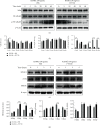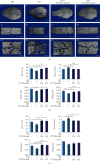FTY720 Attenuates LPS-Induced Inflammatory Bone Loss by Inhibiting Osteoclastogenesis via the NF- κ B and HDAC4/ATF Pathways
- PMID: 36644540
- PMCID: PMC9839404
- DOI: 10.1155/2023/8571649
FTY720 Attenuates LPS-Induced Inflammatory Bone Loss by Inhibiting Osteoclastogenesis via the NF- κ B and HDAC4/ATF Pathways
Abstract
Osteoclast (OC) abnormalities lead to many osteolytic diseases, such as osteoporosis, inflammatory bone erosion, and tumor-induced osteolysis. Exploring effective strategies to remediate OCs dysregulation is essential. FTY720, also known as fingolimod, has been approved for the treatment of multiple sclerosis and has anti-inflammatory and immunosuppressive effects. Here, we found that FTY720 inhibited osteoclastogenesis and OC function by inhibiting nuclear factor kappa-B (NF-κB) signaling. Interestingly, we also found that FTY720 inhibited osteoclastogenesis by upregulating histone deacetylase 4 (HDAC4) expression levels and downregulating activating transcription factor 4 (ATF4) expression levels. In vivo, FTY720 treatment prevented lipopolysaccharide- (LPS-) induced calvarial osteolysis and significantly reduced the number of tartrate-resistant acid phosphatase- (TRAP-) positive OCs. Taken together, these results demonstrate that FTY720 can inhibit osteoclastogenesis and ameliorate inflammation-induced bone loss. Which may provide evidence of a new therapeutic target for skeletal diseases caused by OC abnormalities.
Copyright © 2023 Chongwei Chen et al.
Conflict of interest statement
The authors declare that there is no conflict of interest regarding the publication of this article.
Figures






Similar articles
-
Diallyl disulfide alleviates inflammatory osteolysis by suppressing osteoclastogenesis via NF-κB-NFATc1 signal pathway.FASEB J. 2019 Jun;33(6):7261-7273. doi: 10.1096/fj.201802172R. Epub 2019 Mar 11. FASEB J. 2019. PMID: 30857415 Free PMC article.
-
Stachydrine prevents LPS-induced bone loss by inhibiting osteoclastogenesis via NF-κB and Akt signalling.J Cell Mol Med. 2019 Oct;23(10):6730-6743. doi: 10.1111/jcmm.14551. Epub 2019 Jul 21. J Cell Mol Med. 2019. PMID: 31328430 Free PMC article.
-
LMK-235 suppresses osteoclastogenesis and promotes osteoblastogenesis by inhibiting HDAC4.Sci Rep. 2024 Aug 28;14(1):19973. doi: 10.1038/s41598-024-70814-8. Sci Rep. 2024. PMID: 39198677 Free PMC article.
-
Taxifolin Inhibits Receptor Activator of NF-κB Ligand-Induced Osteoclastogenesis of Human Bone Marrow-Derived Macrophages in vitro and Prevents Lipopolysaccharide-Induced Bone Loss in vivo.Pharmacology. 2019;103(1-2):101-109. doi: 10.1159/000495254. Epub 2018 Dec 6. Pharmacology. 2019. PMID: 30522105
-
Scutellarin inhibits RANKL-mediated osteoclastogenesis and titanium particle-induced osteolysis via suppression of NF-κB and MAPK signaling pathway.Int Immunopharmacol. 2016 Nov;40:458-465. doi: 10.1016/j.intimp.2016.09.031. Epub 2016 Oct 8. Int Immunopharmacol. 2016. PMID: 27728897
Cited by
-
Unraveling the immunogenetic landscape of autism spectrum disorder: a comprehensive bioinformatics approach.Front Immunol. 2024 Apr 24;15:1347139. doi: 10.3389/fimmu.2024.1347139. eCollection 2024. Front Immunol. 2024. PMID: 38726016 Free PMC article.
-
Potential of Liposomal FTY720 for Bone Regeneration: Proliferative, Osteoinductive, Chemoattractive, and Angiogenic Properties Compared to Free Bioactive Lipid.Int J Nanomedicine. 2025 Jan 7;20:239-265. doi: 10.2147/IJN.S494512. eCollection 2025. Int J Nanomedicine. 2025. PMID: 39802384 Free PMC article.
References
MeSH terms
Substances
LinkOut - more resources
Full Text Sources

